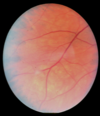Final Review Flashcards
(108 cards)
Where are cotton wool spots usually found?
Within 3-5DD from the disc, as that is where the NFL is thickest
Where are histo streaks usually found?
Mid periphery to equator

Lattice degeneration
What is the leading cause of rhegmatogenous RD?
Horse-shoe tears
Where are hard exudates found?
Outer plexiform layer of retina

Snailtrack degeneration
When is peripapillary atrophy benign?
When mild and associated with myopia
Synchesis can often cause what?
PVD
Horse shoe tears can develop along which margin of WSP?
Posterior margin

Boat Heme (D-shaped)
What is the key difference between toxo and histo?
Active toxo causes inflammatory A/C reaction - KPs, cells, flare

Histoplasmosis

Remnant of Hyaloid Artery
WSP is a sign of what?
Vitreoretinal traction
Bone spicules are a part of what disease?
Retinitis pigmentosa
What are the four types of hemorrhages?
Pre-retina (boat shaped) Flame Dot & blot Sub-retinal

Peripheral “histo streak”
Where is PPA most common?
On the temporal side
Where are vitreoretinal tufts usually seen?
Near equator and ora, but may be seen anywhere
Name three benign “dark” findings
CHRPE Bear Tracks Pigment Crescent
Where does the apex of a horse shoe tear point?
Toward the posterior pole
What are the defining features of central retinal artery occlusion?
Cherry red spot Blanched fundus
What color are atrophic retinal holes?
Red
Which are brighter, hard exudates or drusen?
Hard exudates



























